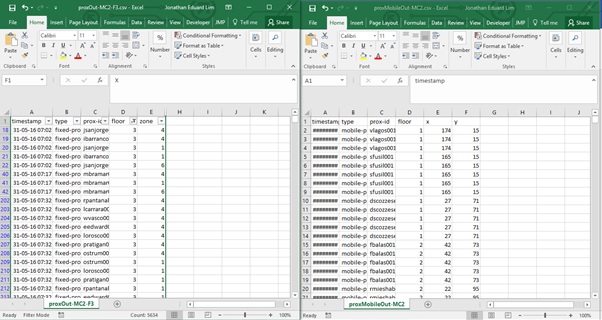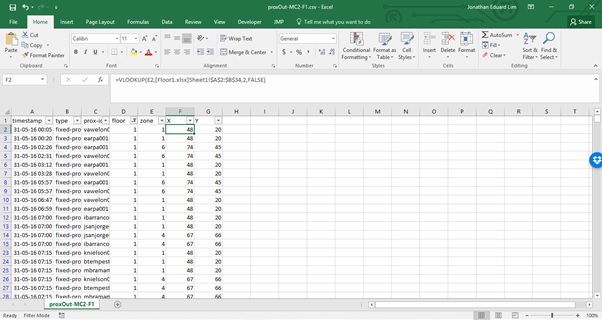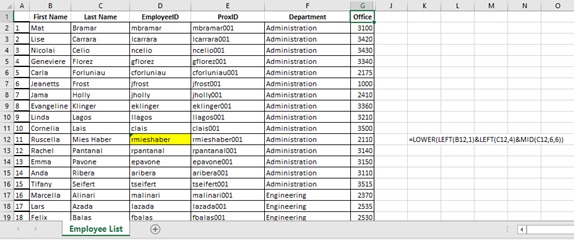Difference between revisions of "IS428 2016-17 Term1 Assign3 Jonathan Eduard Chua Lim"
| Line 121: | Line 121: | ||
====<b>Mobile Prox and Fixed Prox Data:</b>==== | ====<b>Mobile Prox and Fixed Prox Data:</b>==== | ||
| − | |||
| − | I found out that the Fixed Prox Data did not have X and Y axis, and that the Mobile Prox Data did not have a zone value allocated to its dataset. The following is my attempt to bridge the gap. | + | I found out that the Fixed Prox Data did not have X and Y axis, and that the Mobile Prox Data did not have a zone value allocated to its dataset. The following is my attempt to bridge the gap.<br /> |
| + | [[File:InitialProxData.jpg]]<br /> | ||
| + | |||
| + | |||
| + | <b>Fixed Prox Data:</b><br /> | ||
| + | My main assumption is that the the Fixed Proximity Sensor is located in one specific part of the respective zone. | ||
| + | Firstly, I plotted the zones in a custom polygon html ([https://github.com/bryantbhowell/tableau-map-pack/blob/master/draw_tableau_polygons_on_background_image.html| Link here]) and got the X and Y axis in a separate excel file.<br /> | ||
| + | |||
| + | I then used V lookup to generate the X and Y axis for the Fixed Prox Data, with the following formula: =VLOOKUP(E2,[Floor1.xlsx]Sheet1!$A$2:$B$34,2,FALSE) (credit to James Chua). Then I was able to generate the X and Y axis for the Fixed Proximity Data. | ||
| + | [[File:FixedProxVlookup.jpg|FixedProxVlookup.jpg]] | ||
==Findings: What are the typical patterns in the prox card data? What does a typical day look like for GAStech employees?== | ==Findings: What are the typical patterns in the prox card data? What does a typical day look like for GAStech employees?== | ||
Revision as of 22:57, 25 October 2016
Contents
- 1 Questions
- 2 HVAC Information and its Significance
- 3 Data Preparation
- 4 Findings: What are the typical patterns in the prox card data? What does a typical day look like for GAStech employees?
- 5 Findings: Describe up to ten of the most interesting patterns that appear in the building data. Describe what is notable about the pattern and explain its possible significance
- 6 Findings: Describe up to ten notable anomalies or unusual events you see in the data. Prioritize those issues that are most likely to represent a danger or a serious issue for building operations.
- 7 Findings: Describe up to five observed relationships between the proximity card data and building data elements. If you find a causal relationship (for example, a building event or condition leading to personnel behavior changes or personnel activity leading to building operations changes), describe your discovered cause and effect, the evidence you found to support it, and your level of confidence in your assessment of the relationship.
- 8 Visualisations
- 9 Tools used
- 10 References
- 11 Comments and Feedback
Questions
As an expert in visual analytics, you have been hired to help GAStech understand its operations data. In this assignment, you are given two weeks of building and prox sensor data. Can you use visual analytics to identify typical patterns of and issues of concern?
You will be asked to answer the following types of questions:
- What are the typical patterns in the prox card data? What does a typical day look like for GAStech employees?
- Describe up to ten of the most interesting patterns that appear in the building data. Describe what is notable about the pattern and explain its possible significance.
- Describe up to ten notable anomalies or unusual events you see in the data. Prioritize those issues that are most likely to represent a danger or a serious issue for building operations.
- Describe up to five observed relationships between the proximity card data and building data elements. If you find a causal relationship (for example, a building event or condition leading to personnel behavior changes or personnel activity leading to building operations changes), describe your discovered cause and effect, the evidence you found to support it, and your level of confidence in your assessment of the relationship.
HVAC Information and its Significance
| Field | Units | Description |
|---|---|---|
| F_#_BATH_EXHAUST:Fan Power | [W] | Power used by the bathroom exhaust fan |
| F_#_VAV_SYS AIR LOOP INLET Mass Flow Rate | [kg/s] | Total flow rate of air returning to the HVAC system from all zones it serves |
| F_#_VAV_SYS AIR LOOP INLET Temperature | [C] | Mixed temperature of air returning to the HVAC system from all zones it serves |
| F_# VAV Availability Manager Night Cycle Control Status | On/off status of the HVAC system during periods when the system is normally scheduled off. The night cycle manager cycles the HVAC system to maintain night and weekend set point temperatures. | |
| F_#_VAV_SYS COOLING COIL Power | [W] | Power used by the HVAC system cooling coil |
| F_#_VAV_SYS HEATING COIL Power | [W] | Power used by the HVAC system heating coil |
| F_#_VAV_SYS SUPPLY FAN OUTLET Mass Flow Rate | [kg/s] | Total flow rate of air delivered by the HVAC system fan to the zones it serves |
| F_#_VAV_SYS SUPPLY FAN OUTLET Temperature | [C] | Temperature of the air exiting the HVAC system fan |
| F_#_VAV_SYS SUPPLY FAN:Fan Power | [W] | Power used by the HVAC system fan |
| F_#_VAV_SYS Outdoor Air Flow Fraction | Percentage of total air delivered by the HVAC system that is from the outside | |
| F_#_VAV_SYS Outdoor Air Mass Flow Rate | [kg/s] | Flow rate of outside air entering the HVAC system |
| COOL Schedule Value | Example | The supply air temperature set point. Air exiting the HVAC system fan is maintained at this temperature during cooling operation |
| DELI-FAN Power | [W] | Power used by the deli exhaust fan |
| Drybulb Temperature | [C] | Drybulb temperature of the outside air |
| Wind Direction | [deg] | Direction of wind outside of the building |
| Wind Speed | [m/s] | Speed of wind outside of the building |
| HEAT Schedule Value | The supply air temperature set point. Air exiting the HVAC system fan is maintained at this temperature during heating
operation | |
| Pump Power | [W] | Power used by the hot water system pump |
| Water Heater Setpoint | Water heater set point temperature | |
| Water Heater Gas Rate | [W] | Rate at which the water heater burns natural gas |
| Water Heater Tank Temperature | [C] | Temperature of the water inside the hot water heater |
| Loop Temp Schedule | Example | Temperature set point of the hot water loop. This is the temperature at which hot water is delivered to hot water
appliances and fixtures. |
| Supply Side Inlet Mass Flow Rate | [kg/s] | Flow rate of water entering the hot water heater |
| Supply Side Inlet Temperature | [C] | Temperature of the water entering the hot water heater |
| Supply Side Outlet Temperature | [C] | Temperature of the water exiting the hot water heater |
| F_#_Z_# REHEAT COIL Power | [W] | Power used by the zone air supply box reheat coil |
| F_#_Z_# RETURN OUTLET CO2 Concentration | [ppm] | Concentration of C02 measured at the zone's return air grille |
| F_#_Z_# SUPPLY INLET Mass Flow Rate | [kg/s] | Flow rate of the air entering the zone from its air supply |
| F_#_Z_# SUPPLY INLET Temperature | [C] | Temperature of the air entering the zone from its air supply |
| F_#_Z_# VAV REHEAT Damper Position | Position of the zone's air supply box damper. 1 corresponds to fully open, 0 corresponds to fully closed | |
| F_#_Z_#: Equipment Power | [W] | [W] Power used by the electric equipment in the zone |
| F_#_Z_#: Lights Power | [W] | Power used by the lights in the zone |
| F_#_Z_#: Mechanical Ventilation Mass Flow Rate | [kg/s] | Ventilation rate of the zone exhaust fan |
| F_#_Z_#: Thermostat Temp | [C] | Temperature of the air inside the zone |
| F_#_Z_#: Thermostat Cooling Setpoint | [C] | Cooling set point schedule for the zone |
| F_#_Z_#: Thermostat Heating Setpoint | [C] | Heating set point schedule for the zone |
| Total Electric Demand Power | [W] | Total power used by the building |
| HVAC Electric Demand Power | [W] | Total power used by the building's HVAC system including coils, fans and pumps. |
Data Preparation
Modifying Employee Information
- I created an EmployeeID column using the first letter of the employee’s name and the Full last name.
- Generated Prox ID by using the EmployeeID and adding “001”, denoting their first Prox ID card.
- From looking at Mobile Prox Data (Rosie), I have found that employees with 2 last names (ie. Ada Campo-Corrente) or special characters after their last name (ie. Sten Sanjorge Jr) was transformed to “acampo” and “jsanjorge” respectively.
- The formula and the transformation for these special types of proxid can be seen below.
| First Name | Last Name | Transformed Employee ID | Formula |
|---|---|---|---|
| Ruscella | Mies Haber | rmieshaber | =LOWER(LEFT(B12,1)&LEFT(C12,4)&MID(C12,6,6)) |
| Ada | Campo-Corrente | acampo | =LOWER(LEFT(B53,1)&LEFT(C53,5)) |
| Sten | Sanjorge Jr. | jsanjorge | =LOWER(MID(C58,10,1)&MID(C58,1,8)) |
| Willem | Vasco-Pais | wvasco | =LOWER(LEFT(B60,1)&LEFT(C60,5)) |
Mobile Prox and Fixed Prox Data:
I found out that the Fixed Prox Data did not have X and Y axis, and that the Mobile Prox Data did not have a zone value allocated to its dataset. The following is my attempt to bridge the gap.

Fixed Prox Data:
My main assumption is that the the Fixed Proximity Sensor is located in one specific part of the respective zone.
Firstly, I plotted the zones in a custom polygon html (Link here) and got the X and Y axis in a separate excel file.
I then used V lookup to generate the X and Y axis for the Fixed Prox Data, with the following formula: =VLOOKUP(E2,[Floor1.xlsx]Sheet1!$A$2:$B$34,2,FALSE) (credit to James Chua). Then I was able to generate the X and Y axis for the Fixed Proximity Data.

